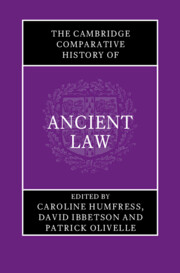52 results

The Cambridge Comparative History of Ancient Law
- Coming soon
-
- Expected online publication date:
- May 2024
- Print publication:
- 30 May 2024
-
- Book
- Export citation
Johannes Bronkhorst: How the Brahmins Won: From Alexander to the Guptas. (Handbook of Oriental Studies.) xviii, 572 pp. Leiden: Brill, 2016. ISBN 978 90 04 31519 8.
-
- Journal:
- Bulletin of the School of Oriental and African Studies / Volume 81 / Issue 1 / February 2018
- Published online by Cambridge University Press:
- 23 February 2018, pp. 156-158
- Print publication:
- February 2018
-
- Article
- Export citation
V - Power of Words: The Ascetic Appropriation and the Semantic Evolution of dharma
-
- Book:
- Language, Texts, and Society
- Published by:
- Anthem Press
- Published online:
- 05 May 2012
- Print publication:
- 15 December 2011, pp 121-136
-
- Chapter
- Export citation
16 - Renouncer and Renunciation in the Dharmaśāstras
-
- Book:
- Ascetics and Brahmins
- Published by:
- Anthem Press
- Published online:
- 05 February 2013
- Print publication:
- 15 December 2011, pp 271-292
-
- Chapter
- Export citation
2 - The Ascetic and the Domestic in Brahmanical Religiosity
-
- Book:
- Ascetics and Brahmins
- Published by:
- Anthem Press
- Published online:
- 05 February 2013
- Print publication:
- 15 December 2011, pp 27-42
-
- Chapter
- Export citation
III - Orgasmic Rapture and Divine Ecstasy: The Semantic History of ānanda
-
- Book:
- Language, Texts, and Society
- Published by:
- Anthem Press
- Published online:
- 05 May 2012
- Print publication:
- 15 December 2011, pp 75-100
-
- Chapter
- Export citation
6 - The Beast and the Ascetic: The Wild in the Indian Religious Imagination
-
- Book:
- Ascetics and Brahmins
- Published by:
- Anthem Press
- Published online:
- 05 February 2013
- Print publication:
- 15 December 2011, pp 91-100
-
- Chapter
- Export citation

Ascetics and Brahmins
- Studies in Ideologies and Institutions
-
- Published by:
- Anthem Press
- Published online:
- 05 February 2013
- Print publication:
- 15 December 2011
XV - Hair and Society: Social Significance of Hair in South Asian Traditions
-
- Book:
- Language, Texts, and Society
- Published by:
- Anthem Press
- Published online:
- 05 May 2012
- Print publication:
- 15 December 2011, pp 321-350
-
- Chapter
- Export citation
3 - Village vs. Wilderness: Ascetic Ideals and the Hindu World
-
- Book:
- Ascetics and Brahmins
- Published by:
- Anthem Press
- Published online:
- 05 February 2013
- Print publication:
- 15 December 2011, pp 43-62
-
- Chapter
- Export citation
XVII - Food for Thought: Dietary Rules and Social Organization in Ancient India
-
- Book:
- Language, Texts, and Society
- Published by:
- Anthem Press
- Published online:
- 05 May 2012
- Print publication:
- 15 December 2011, pp 367-394
-
- Chapter
- Export citation
5 - From Feast to Fast: Food and the Indian Ascetic
-
- Book:
- Ascetics and Brahmins
- Published by:
- Anthem Press
- Published online:
- 05 February 2013
- Print publication:
- 15 December 2011, pp 71-90
-
- Chapter
- Export citation
13 - The Renouncer's Staff: triviṃṭabdha, tridaṇḍa, and ekadaṇḍa
-
- Book:
- Ascetics and Brahmins
- Published by:
- Anthem Press
- Published online:
- 05 February 2013
- Print publication:
- 15 December 2011, pp 231-248
-
- Chapter
- Export citation
12 - Ritual Suicide and the Rite of Renunciation
-
- Book:
- Ascetics and Brahmins
- Published by:
- Anthem Press
- Published online:
- 05 February 2013
- Print publication:
- 15 December 2011, pp 207-230
-
- Chapter
- Export citation
Index
-
- Book:
- Language, Texts, and Society
- Published by:
- Anthem Press
- Published online:
- 05 May 2012
- Print publication:
- 15 December 2011, pp 413-419
-
- Chapter
- Export citation
References
-
- Book:
- Language, Texts, and Society
- Published by:
- Anthem Press
- Published online:
- 05 May 2012
- Print publication:
- 15 December 2011, pp 395-412
-
- Chapter
- Export citation
XVI - Abhakṣya and Abhojya: An Exploration in Dietary Language
-
- Book:
- Language, Texts, and Society
- Published by:
- Anthem Press
- Published online:
- 05 May 2012
- Print publication:
- 15 December 2011, pp 351-366
-
- Chapter
- Export citation
10 - Renunciation in the Saṃnyāsa Upaniṣads
-
- Book:
- Ascetics and Brahmins
- Published by:
- Anthem Press
- Published online:
- 05 February 2013
- Print publication:
- 15 December 2011, pp 165-196
-
- Chapter
- Export citation
IV - Amrtā: Women and Indian Technologies of Immortality
-
- Book:
- Language, Texts, and Society
- Published by:
- Anthem Press
- Published online:
- 05 May 2012
- Print publication:
- 15 December 2011, pp 101-120
-
- Chapter
- Export citation
VI - Semantic History of Dharma: The Middle and Late Vedic Periods
-
- Book:
- Language, Texts, and Society
- Published by:
- Anthem Press
- Published online:
- 05 May 2012
- Print publication:
- 15 December 2011, pp 137-154
-
- Chapter
- Export citation



